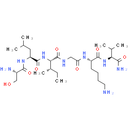Description
Protease-Activated Receptor-2, amide (SLIGKV-NH2) is a highly potent protease-activated receptor-2 (PAR2) activating peptide.
Product information
CAS Number: 190383-13-2
Molecular Weight: 614.78
Formula: C28H54N8O7
Chemical Name: (2S)-6-amino-2-[[2-[[(2S, 3S)-2-[[(2S)-2-[[(2S)-2-amino-3-hydroxypropanoyl]amino]-4-methylpentanoyl]amino]-3-methylpentanoyl]amino]acetyl]amino]-N-[(2S)-1-amino-3-methyl-1-oxobutan-2-yl]hexanamide
Smiles: C[C@@H](CC)[C@H](NC(=O)[C@H](CC(C)C)NC(=O)[C@@H](N)CO)C(=O)NCC(=O)N[C@@H](CCCCN)C(=O)N[C@@H](C(C)C)C(N)=O
InChiKey: HOWDUIVVWDUEED-WAUHAFJUSA-N
InChi: InChI=1S/C28H54N8O7/c1-7-17(6)23(36-27(42)20(12-15(2)3)34-25(40)18(30)14-37)28(43)32-13-21(38)33-19(10-8-9-11-29)26(41)35-22(16(4)5)24(31)39/h15-20,22-23,37H,7-14,29-30H2,1-6H3,(H2,31,39)(H,32,43)(H,33,38)(H,34,40)(H,35,41)(H,36,42)/t17-,18-,19-,20-,22-,23-/m0/s1
Technical Data
Appearance: Solid Power
Purity: ≥98% (or refer to the Certificate of Analysis)
Solubility: H2O : 33.33 mg/mL (54.21 mM; Need ultrasonic).
Shipping Condition: Shipped under ambient temperature as non-hazardous chemical or refer to Certificate of Analysis
Storage Condition: Dry, dark and -20 oC for 1 year or refer to the Certificate of Analysis.
Shelf Life: ≥12 months if stored properly.
Stock Solution Storage: 0 - 4 oC for 1 month or refer to the Certificate of Analysis.
Drug Formulation: To be determined
HS Tariff Code: 382200
How to use
In Vitro:
The PAR2-activating peptides used are: SLIGKV-OH, SLIGRL-OH, SLIGKV-NH2, SLIGRL-NH2. The synthetic agonist peptides mimicking the tethered ligand of PAR2, Ser-Leu-Ile-Gly-Lys-Val (SLIGKV-OH), Ser-Leu-Ile-Gly-Arg-Leu (SLIGRL-OH) and their amidated forms Ser-Leu-Ile-Gly-Lys-Val-amide (SLIGKV-NH2) Ser-Leu-Ile-Gly-Arg-Leu-amide (SLIGRL-NH2) have also been demonstrated being able to activate the receptor without enzymatic cleavage, therefore, have been utilised as biological tools to examine physiological functions of PAR2. Protease-Activated Receptor-2, amide is one of a four family subgroup of G-protein-coupled receptors (GPCRs), called PARs. Protease-activated receptors are distinguished from other GPCRs through their unique proteolytic mechanism of activation. For PAR2, activating proteases, such as trypsin, tryptase and coagulation factors VIIa and Xa, cleave a specific extracellular amino-terminal domain of the receptor to reveal a "tethered ligand", SLIGKV- and SLIGRL- for human and mouse/rat PAR2, respectively, which subsequently interacts with the activation domain of the receptor, initiating intracellular signaling pathways. The protease-activated receptor-2 (PAR2) has been implicated in the pathogenesis of several inflammatory and autoimmune disorders, and is expressed in a wide variety of human tissues and cells. PAR2 belongs to a family of seven transmembrane domain receptor proteins that are activated by proteolysis. Enzymatic digestion exposes an N-terminus ligand sequence that binds intramolecularly to the activation site on the extracellular loop II, initiating a G-protein-mediated cell-signalling cascade and nuclear factor-kappa B (NF-κB)-regulated gene transcription.
References:
- Kanke T, et al. Binding of a highly potent protease-activated receptor-2 (PAR2) activating peptide, [3H]2-furoyl-LIGRL-NH2, to human PAR2. Br J Pharmacol. 2005 May;145(2):255-63.
- Ramelli G, et al. Protease-activated receptor 2 signalling promotes dendritic cell antigen transport and T-cellactivation in vivo. Immunology. 2010 Jan;129(1):20-7.
Products are for research use only. Not for human use.
Payment & Security
Your payment information is processed securely. We do not store credit card details nor have access to your credit card information.


